A month ago with a bated breath the entire world watched an event worthy of the name of the “Wedding of a 21st Century”. Prince Albert of Monaco married a beautiful blonde Charlene, a former Olympic world swimming champion from South Africa. And on Friday 5th the bride appeared for the first time officially in her new status at the “Bal de la Croix Rouge”. H.S.H. Princess Charlene’s head was decorated with a tiara of white gold, encrusted with soft blue sapphires and diamonds – the symbols of power. Same as a little more than half a century before, at the wedding of Grace Kelly and Rainier III (the “Wedding of the 20th Century”) the jewellery for Princess Charlene were made on special order by the official jewellery house of principality of Monaco – Van Cleef & Arpels.
We were graciously received by Nicolas Bos – the CEO of Van Cleef & Arpels America and the artistic director of the group at the company’s headquarters, at the rue de la Paix, a stone’s throw from the jewellery heart of Paris – Place Vendôme. Obviously Van Cleef & Arpels has a boutique at this square too. Walking past its windows creates a sense of fairy tales where a time has stopped or just has no meaning.
Could you give our readers the brief history of the House?
It started a few meters away, at 22, Place Vendôme, where we still have our major boutique today, in 1906 when Alfred Van Cleef and Estelle Arpels created a jewellery company. At that time Paris was a center of the world and the most famous jetsetters came here and stayed in the luxurious and fashionable newly opened Ritz hotel, which is situated at Place Vendôme as well. Other jewellery maisons, including royal families’ suppliers, were neighbouring Ritz so that new international elite quickly became clients of these jewellers.
Soon, following its success in Paris, Van Cleef &Arpels opened other boutiques in Europe but also in the USA, where the first store was inaugurated in 1939. And it was like a start of a second history of the house. But the roots: workshops, the design studio and the precious stones selection department stayed in Paris thus the name of our company has been always associated with traditional French high jewellery.
How did you come to the world of high jewellery?
Both by passion and coincident. I have been always interested in creation and art. Different kinds of art: visual, musical, painting, jewellery.. I joined Van Cleef &Arpels in 2000. Before that I used to work within the same group Richemont. I worked with the Cartier’s Private Foundation for Contemporary Art.
You occupy two different positions which seem to be incompatible; are you more into business or creativity?
In our activity – decorative art – both need to coexist. We are artists by definition, but all our enterprise makes sense only if we manage to make business with it. That’s where the founders of Van Cleef &Arpels were especially good at – combination of art and business, creation of exceptional pieces of high jewellery for the clients, taking into consideration their interests and demands.
In comparison with high couture, do you follow any seasonal trends?
We don’t really submit to fashion seasons since a creation of a jewellery collection may take up to 3 years. So we cannot be dependent on seasonal trends. What I suppose to be interesting to mention as a specificity of high jewellery is the comeback of creativity in the last 10-15 years. If you look back to the beginning of the last century and even in the 50ties and 60ties, you’ll see that the high jewellery was among the most creative fields of the decorative art. The same as furniture design, couture or the theatre’s décor – the categories of the decorative art where an artistic inspiration and mastering of certain technique are needed. And then it became dormant for several decades. The high jewellery was more focusing on exceptional stones and traditional settings but the figurative design did not evolve a lot. In a certain way the creativity was somehow replaced by ‘costume’ jewellery – more classical, less fantasy pieces. And now the creativity is coming back. Today the jewellers can mix precious stones like emeralds, sapphires, diamonds, rubies with fine stones such as onyxes, turquoises, amethysts, tourmalines – which was actually a tradition fifty years ago. Our ‘business’ is becoming exciting again! It’s getting more adapted to different tastes and life styles.
There is some confusion between high and fine jewellery, could you define what is high jewellery in Van Cleef &Arpels’ interpretation?
We try to establish and apply to our house the definitions which exist for haute couture and prêt-à-porter designers. It concerns first of all the house itself: it has to have its own workshop with a manufacturing tradition as well as a creative studio and master all steps from the very first inspiration to the final piece. The production must also be very limited by a very restricted number of extremely skilled jewellers, our ‘golden hands’, and by the very high quality of selected stones. All our high jewellery pieces are unique. We have also more ‘day wear’ pieces which are produced in a small quantity but within the repetitive collection. But the people who design the unique and ‘day wear’ pieces are the same. What is the most important for us is the quality of stones and the technique.
Do you adapt your collections to the different regional markets following the different tastes of your clients?
No, what we do is more about style which I believe is universal. We create what we feel is relevant and tell the stories that we want to tell. Certainly we respect our clients, their different lifestyle and traditions. Surprisingly, we have noted that we have been selling an extremely sophisticated complex design necklace to clients in the middle of America or in the Middle East where traditionally massive jewellery with big stones are appreciated. While classical, rather minimalistic pieces – to the clients who wear vanguard couture. Thus there are no strict rules for local marketing in high jewellery. Generally we appeal to the clients who have a certain cultural level, sophisticated tastes and are able to make the difference in terms of quality and inspiration.
Your new collection is called ‘Bals de Legénde’, what were your inspired by?
We were inspired by five masquerade balls of the 20th century which represented remarkable events in the history of social and cultural life. What is interesting and in some way attractive in masquerade balls is a sense of nostalgia for past time; the idea of disappeared lifestyle. Big sumptuous celebrations, royal weddings – all this belongs to the past.
Talking about royal weddings, we all saw new Princess of Monaco Charlene wearing the Van Cleef &Arpels high jewellery masterpiece at her Bal de la Croix Rouge..
Indeed, with two royal wedding first in England a couple of weeks ago and in Monaco two days ago we had the glamorous opportunities to see what a royal wedding could be like in 2011.
The house of Van Cleef &Arpels had the great honour to be selected by the principality of Monaco, by Princess Charlene and Prince Albert themselves for the wedding gift of Albert. It is a very special piece which is called ‘Ocean’ – a princess tiara which could also be worn as a necklace. Its creation was inspired by the personality of Charlene and the history of Monaco. Simple, modern and elegant style of Charlene marries her swimming past to the story of Monaco which is also very connected with the water. We tried to express the lightness and simplicity of the waves’ movement in a combination of diamonds and sapphires. Hereby we are continuing to be the official jeweller of the principality of Monaco since the time of Princess Grace Kelly and Prince Rainier who had very close relationship with our house.
Coming back to your last collection ‘The legendary balls’: which were those five balls of legend which became your source of inspiration?
When we work on the high jewellery collections we take inspiration from themes and elements which stay outside of the field of jewellery and are always connected with the history of the art.
The starting point for the new collection was a photo portrait of Liz Taylor of 1971 at a party that was called the ‘Proust ball’ given by the Rothschild family in a castle outside of Paris. Liz Taylor was wearing Van Cleef & Arpels necklace in her hear. Absolutely beautiful, with the very 19th century elegance created by the photographer. We started by trying to find out where the picture come from and what was that ‘Proust ball’. We discovered that it was an amazing costume party celebrating the 100th anniversary of Marcel Proust. The particularity of this masquerade was that all guests were wearing costumes of the Proust characters.
Actually it was one of a series of balls given by the Rothschild family and others high society hosts. We discovered a fascinating history of masquerade balls in twenty century in Europe where some aristocratic families, great artists or fashion designers thereby created a form of art. The host selected the place and the theme of ball, the list of guests and told them in advanced how they should dress. What was special about the balls of the twentieth century is that together with traditional aristocracy and royal families the renowned artists were involved in celebrations – they could create the décor, make musical or ballet performance.
Some costumes were very eccentric others more classical; very often they incorporated some jewellery. Thus our house was constantly in connection with these parties since many of their guests and hosts were our clients.
We have selected five balls starting with the Russian “Winter Palace” ball of 1903 in Saint Petersburg, the one that somehow was the last of the great traditional aristocratic balls given by the Romanov royal family. All guests were dressed in 17th century traditional Russian costumes. That was very bizarre and unexpected at a time when the fashion was dictated by “modern” Europe.
Then we moved to another “legendary ball”, the one called “The Party of the Century” given in 1951 by the Mexican aristocrat Charles de Beistegui who lived in France; the ball took place at the Palazzo Labia – a masterpiece of 18th century baroque – which is situated on the Grand Canal in Venice and which was reopened for this occasion. For the first time in balls history guests who belonged to great aristocratic families were mixed with movie stars who stayed in Venice for the occasion of the film festival. Very rich Venetian costumes of 18th century together with masks have inspired our designers to create this chapter of our collection.
Next ball, the atmosphere of which is completely different from the previous one, was called “Black and White” and took place in New York in 1966. It was organized by the famous American writer Truman Capote at the Plaza Hotel. The seemingly simple theme – black and white- was interpreted by guests either in a very extravagant or in a very plain way. From the point of view of jewellery creation such theme revealed a real challenge since we are much more used to reach color palette in our collections. All the more so we were very happy with the result – simple and strong elegant art-deco pieces with white diamonds and black spinel reminding the New York architecture with its skyscrapers.
The next chapter of collection is inspired by the “Oriental Ball” of 1969 which took place in the 17th century Hotel Lambert on the Saint-Louis Island in Paris. The party was organized by Baron Alexis de Rédé. The theme, very rich in colours and imagination, was inspired by “thousand and one night”: a dream vision of Asia. Lots of pieces in our collection were inspired by the embroidery and the Indian silk, Thai flames and oriental dancers.
The last “Proust Ball” (the one we started with, where Liz Taylor was among the guests) was given by Baron Guy de Rothschild and his wife in 1971. It took place in a 19th century castle built in Italian Renaissance style twenty-five kilometres from Paris. We tried to create the pieces full of romance and delicateness in order to reproduce the atmosphere of the Proust’s “Remembrance of Things Past” characters.
We have published a book as well where we gathered all the materials concerning these five balls of the 20y century which helped us while creating this collection.
Interviewed by Tatiana Stolyarova and Rodion Denisyuk
Photo credits: Van Cleef & Arpels

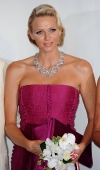

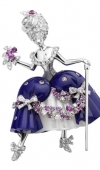
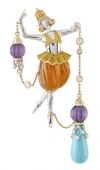
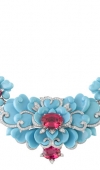

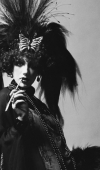
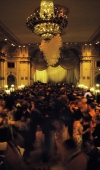
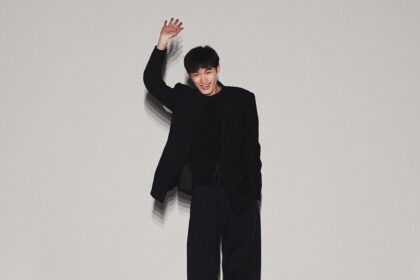
[…] more here: Nicolas Bos (Van Cleef & Arpels) – haute|hot couture news Van Cleef and Arpels First Premier Bouquet Perfumed Body LotionA subtly perfumed milky […]